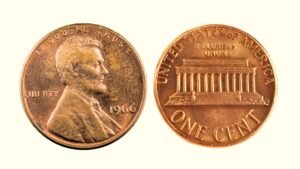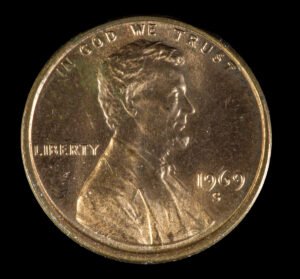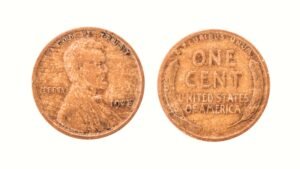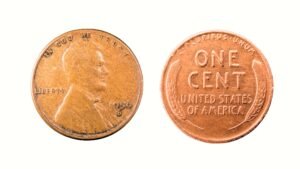Look for an old 1970 Lincoln penny in your change jar now; you might have a hidden copper gem worth as much as $24,000! That’s right, this small cent can fetch big bucks today thanks to its rare Small Date and Large Date varieties and unique minting errors. But that’s not it! Find out what else makes your 1970 copper cent valuable in this guide!

A Brief of 1970 Lincoln Penny’s Interesting History
The 1970 Lincoln Memorial cent was part of the ongoing series of one-cent pieces that featured Victor David Brenner’s iconic Lincoln portrait on the obverse and Frank Gasparro’s Lincoln Memorial design on the reverse, which had been introduced in 1959.
The U.S. Mint produced these cents at three facilities in 1970: Philadelphia (no mint mark), Denver (D), and San Francisco (S). The total combined mintage was approximately 1.89 billion pieces, making it a relatively common date for collectors.
The most notable feature of 1970 cents is the existence of both Small Date and Large Date varieties. The Small Date features a shorter, more compact “7” in the date, while the Large Date shows a taller, more prominent “7” with a longer diagonal serif.
Besides, this was one of the last decades where the penny’s metal content was worth close to its face value before copper prices began to rise significantly.
| 1970 Lincoln Memorial Cent | Key Features & Facts |
| Coin Composition | 95% Copper, 5% Tin and Zinc |
| Minting Location | Philadelphia, Denver, San Francisco |
| Minting Year | 1970 |
| Face Value | 1-cent (0.01$) |
| Weight | 3.11 grams |
| Diameter | 19.05 mm |
| Thickness | 1.52 mm |
| Designer | Victor David Brenner, Frank Gasparro |
| Mint Marks | D – Denver Mint, S – San Francisco Mint, No Mint Mark – Philadelphia Mint |
| Total Mintage | 5,482,946,714 coins |
Identifying a 1970 Lincoln Cent Design & Features
Before you start assessing your 1970 Lincoln Memorial penny value, be sure to verify its design elements of both sides, composition, and other physical characteristics.
1970 Lincoln Penny Obverse:

- A right-facing portrait of Abraham Lincoln
- “IN GOD WE TRUST” above Lincoln’s head
- “LIBERTY” to Linconl’s back
- The mint date “1970” to the right of Lincoln’s chest
- The mint mark D or S, if present, below the mint year
1970 Lincoln Cent Reverse:

- Image of the Lincoln Memorial at the center
- “UNITED STATES OF AMERICA” along the upper edge
- “E PLURIBUS UNUM” right above the building
- “ONE CENT” in large font at the bottom
- The designer’s initials, “FG” for Frank Gasparro, to the right of the building staircase
Composition, Weight & Dimensions
The 1970 Lincoln penny is composed primarily of 95% copper and 5% tin and zinc, a bronze alloy that had been used for Lincoln cents since 1909. This unique composition gives the small cent its distinctive red color and an ideal weight of 3.11 grams.
Besides, the 1970 penny has a diameter of almost 19 millimeters and a thickness of approximately 1.52 millimeters, with a non-reeded smooth edge.
4 Key Factors to Assess a 1970 Lincoln Penny Value
The average value of a circulated 1970 Lincoln Memorial penny ranges from a few cents to a dollar or two, while uncirculated examples in excellent condition can fetch high values of up to $24,000 or more, depending on their condition, mint marks, and rare minting errors.
1. Coin Grades & Condition
The first and most important factor influencing your 1970 Lincoln cent value is its condition, which is professionally evaluated in “coin grades.” These grades range from P-1 to MS-70, where higher grades mean better conditions and, hence, higher values.
For example, a regular 1970 penny graded MS67+ was sold for a whopping $4,406 on Heritage Auctions, while the same coin is only worth around $5-10 in MS-65 grade and $0.05 to $1 in MS-62 grades.
The color of your coin also indicates its condition. Generally, the Lincoln copper pennies have three color categories based on toning: red, red-brown, and brown.
Red pennies which retained over 95% of their original red color (new-like or uncirculated coins) are the most sought-after coins. Red-brown coins with both red and brown toning and Brown pennies with over 95% oxidation/toning are worth less, typically around $5 to $30, depending on mint marks.
Generally, you can assess your coin’s condition based on its shine, sharpness of the details, and color. The more your coin looks similar to a new 1970 penny, the more valuable it will be. However, getting your coin graded by a professional coin grading service is still a wiser option.
2. Mint Marks & Mintage
The mintage of the coin (the total production) decides whether the coin is rare or common; the lower the mintage, the rarer and more collectible the coin. The 1970 penny has a total mintage of over 5.4 billion coins, which means it’s quite common.
However, minted at three locations, each with its unique mint mark and mintage impacting their final values:
| Coin Grades | Condition Details | 1970 No Mint Mark Penny Value | 1970 D Penny Value | 1970 S Penny Value |
| Poor (0) to Extremely Fine (XF45) | Significant wear, faded but visible details | 1-2 cents | 1-2 cents | 10 – 20 cents |
| Almost Uncirculated (AU50) to Mint State (AU58+) | Slight wear on highest points, visible marks or blemishes | 20 cents to 50 cents | 10 cents to 30 cents | 50 cents to $1 |
| Mint State (MS60 – MS64) | Uncirculated with minimal wear | $1 – $7 | $1 – $6 | $5 – $15 $30 – $55 (SD) |
| Mint State (MS65 – MS66+) | Nearly flawless with very minor imperfections | $7 – $30 | $7 – $50+ | $7 – $60 (LD) $30 – $250 (SD) |
| Mint State (MS67 – MS67+) | Well-preserved with no major flaws | $115 – $4,500+ | $100 – $2,820+ | $130 – $700 (LD) $380 – $2,500 (SD) |
| Mint State (MS68 or Above) | Nearly perfect, luster, no major marks or flaws | N/A | N/A | N/A |
1970 No Mint Mark Penny Value (Mintage – 1,898,315,000)
The Philadelphia Mint produced over 1.8 billion 1970 Lincoln cents, making them quite easily available and common. These coins are only worth a few cents in circulated condition. However, uncirculated coins in mint grades MS-65 to MS67 can range from $7 to $250. MS67+ and higher grades are quite rare, so they can fetch $4,000 or more!
1970 D Lincoln Penny Value (Mintage – 2,891,438,900)
The Denver Mint struck even more Lincoln cents than Philadelphia, crossing the 2.89 billion mark. More common than the no-mint mark penny, the 1970 D Lincoln cent is typically worth the face value.
In uncirculated condition, the value can range from $5 to $500 in MS-62 to MS-67 grades, while MS-67+ sold for $2,820 on Heritage Auctions!
1970 S Lincoln Penny Value (Mintage – 690,560,004)

The San Francisco-minted 1970 S Lincoln cents are the most valuable due to the lowest mintage of around 690.5 million coins and its two popular varieties, Small Date and Large Date coins.
1970 S Large Date Penny
This 1970 S penny variety can be identified by the bold and large digits on the mint date. Generally, these coins are worth around $7 to $380 or more in MS-62 to MS-67 grades. Higher grades of this variety are rarely found and can fetch more.
1970 S Small Date Penny
As the name hints, this 1970 S Lincoln cent variety has a small mint date “1970” with thin and small digits, especially noticed in the digit 9. These coins are rarer than the Large Date variety and, hence, can fetch more in high grade.
For example, an MS-67 1970-S Small Date penny can range from $400 to $2,500 or more, as this example sold for $2,310 at Legend Rare Coin Auctions. MS-62 to MS-64 grades generally sell for $20 to $60 and MS-65 to MS66+ examples can fetch up to $200!

3. 1970 S Lincoln Penny Proof Strike (Mintage – 2,632,810)
In addition to the business cents, the San Francisco Mint also released over 2.6 million proof 1970 Lincoln cents for coin collectors. Like regular 1970 S pennies, these coins feature the S mint mark on the obverse and are also found in small and large date varieties.
1970 S Small Date Proof Penny
The 1970 S Small Date proof penny features small letters, prominently visible in its “High 7” with its upper bar falling right in front of the “9’s” top. Standard proof versions of this Small Date variety typically range from $10 to $950 in PR64 to PR69 grades.
Cameo 1970 S Small Date proof pennies are rarer, fetching $60 to $1,100 for PR65 to PR69 grades. The most valuable of all, the Deep Cameo version of the Small Date variety is worth $3,300 to $9,500 in PR69 grades and $75 to $750 in PR65 to PR68 grades. PR70 examples of this variety are rare, so they can be quite pricey if found!
1970 S Large Date Proof Penny
This proof variety can be spotted with its large date digits and the lower horizontal bar of “7.” Generally valued less than the Small date-proof coins, a standard 1970 S Large Date proof penny in PR62 to PR69 grades is worth $5 to $40, and in PR70 grades, worth $1,000 to $2,500.
The value of the Cameo version ranges from $7 to $250 in PR63 to PR69 and that of Deep Cameo 1970 S Large Date proof penny ranges from $10 to $850 or more, based on grades.

4. Rare 1970 Lincoln Penny Errors
The following minting errors can significantly hike your 1970 Lincoln cent value:
1970-S Large Date Double Die Obverse
The most popular error on a 1970 Lincoln Penny is the Double Die Obverse error. Look for the doubling in the mint date “1970,” lettering in “LIBERTY” and “IN GOD WE TRUST” and Lincoln’s silhouette.
Depending on the condition and visibility of the doubling, a 1970-S LD DDO penny can easily fetch $1,800 to $16,000 in MS63 to MS65 grades. The highest-grade LD DDO coin to be found, an MS66 example sold for an auction record price of $24,150 as per PCGS!

Struck on Clad Dime Planchet
1970 cents struck on clad dime planchets occurred when the Lincoln penny design was accidentally struck on Roosevelt dime planchet. These appear smaller and lighter than normal cents and have a silvery gray color.
Based on recent auction data, the wrong planchet 1970 penny errors typically sell for $300-500 in circulated grades, while uncirculated examples can reach $800-3,000 or more, like this PR-64 graded example sold for $2,990 on Heritage Auctions!
Struck Through Late Stage Die Cap
A Stage Die Cap errors occur when a 1970 penny coin sticks to the die and strikes multiple planchets, creating increasingly distorted impressions and capped coins. Depending on the grade and color, these coins can fetch $10 to $200, with more intense examples reaching $500.
Off-center Strike Error
This error happens when a 1970 Lincoln cent planchet is misaligned between the dies, resulting in part of the design missing. These errors are not that expensive though, fetching $20 to $1,000, depending on the percentage off-center, the date’s visibility, and the coin’s condition.
For example, an MS65 RB 1970-D Penny with 65% off-center strike sold for over $40. Red coins with more dramatic errors could fetch more.

Broadstruck Error
Broadstruck cents (struck outside the collar) from 1970 are relatively common errors and, hence, won’t fetch a lot. They generally sell for $30-150 in uncirculated state, depending on grades. For example, this MS64RB 1970-D broadstruck penny sold for $45!
Obverse Die Cap Struck on Dime Planchet
This rare error combines two major errors; wrong planchet error (on a dime planchet) and obverse die cap error, making it extremely rare. You can identify this by its silvery gray color and its capped edges.
Recent auctions show these rare 1970 pennies selling for $1,000-2,000, like this MS66 example, bought for $1,380 on Heritage Auctions!
Struck Five Times
This rare 1970 Lincoln Memorial cent was accidentally struck five times, each with misaligned overlapping impressions. Being extremely rare, an MS64RD example of this unique error sold for over $920 in a coin auction, which is an exceptional price for MS65 1970 pennies!
Multistruck on 10C Planchet
This is another striking error in which the die struck a 1970 Lincoln penny on a 10-cent planchet multiple times creating slightly overlapping impressions on a larger coin. The weight of this coin is 2.2 grams against a penny’s 3.11 grams.
Due to its high rarity, this coin can fetch thousands of dollars. For example, a rare PR66 1970-S Penny Multistruck on a 10C Planchet sold for a stunning price of $2,640 on Heritage Auctions!
In addition to these, common errors like Cud Die Break and Re-punched mint marks can also hike your old 1970 penny value. Once you’ve identified all the rare features, you can easily sell or buy this small yet valuable copper coin!
Note: This article is intended for informational, educational, and entertainment purposes only. Some images are illustrative and may not represent actual brands, products, or related entities. All trademarks, product names, brand logos, packaging, and other intellectual property referenced remain the exclusive property of their respective owners. Any brand mentions or references are provided solely for descriptive and educational context and do not imply any formal or commercial association.








